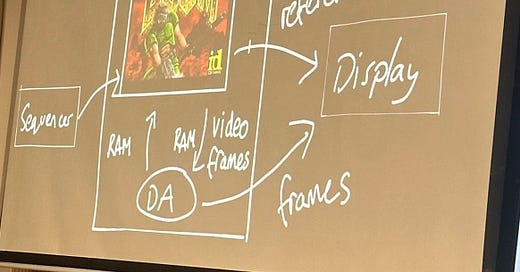DOOM Decentralized, Brie’s Biles-1, & EU’s Peace Efforts
Bits of Signum Growth Dot Play | 03.02.2025
When I tell people that I have been excited about the games industry since my first E3 twenty years ago, they are usually wondering if I play First Person Shooters (FPS) like DOOM. The unsurprising answer is no (even though I do love other games!) In fact, I still remember the cold, hard fear I felt while watching the latest version on the mega screen at my first games conference. The real answer is that I am a student of emerging technologies and behavior change, and new technologies are typically first used in the cutting edge environment of video games. While you can find examples in the early 1950s of AI in video games, AI really became prolific commercially in the 1970-1980s with games like Pong and Pac-Man.
What happened this weekend?! In addition to Brie Clark pushing the bounds of the human body, an historic technological breakthrough was demonstrated when Gavin Wood (@gavofyork) demonstrated DOOM running on a Decentralized Web Services Machine. This isn’t about the game DOOM, but rather about demonstrating a regular application that can run on Polkadot. This is important because a blockchain by itself can't typically run regular applications since there is only so much “work” that can be done by a single block.
Shawn Tabrizi explained, “This proves Polkadot is not simply a blockchain. It is a fully fledged, decentralized supercomputer.” This opens the door to all kinds of applications living on chain, which was never before possible.
@Pala_Labs said, “JAM shows blockchains can go beyond transactions, enabling decentralized computing with continuous execution flow. It’s a breakthrough moment for Web3 computing.”
Emil Keitzman explained - This wasn't a modified version of Doom to put it on the blockchain - just the original game recompiled to target the Polkadot Virtual Machine (PVM). PVM powers JAM's computational layer (like EVM in Ethereum). The demo proved JAM can handle general-purpose computation, not just blockchain-specific tasks. It's the first step to bring web2->web3, as JAM just runs arbitrary software. Read more in the post on how it works.
@Alice_und_Bob also breaks it down in several ways - Today developers have to think very constrained. They have to write code that fits inside a block. On short transactions. This is a huge limitation. Gavin’s invention removes that limitation and opens it up to write any program on JAM. It proves you can run normal software on a fully on-chain Virtual Machine - without modifications. Not just smart contracts. Any app!!! This isn’t just about gaming. It’s a glimpse into a future where entire applications run trustless & decentralized - unstoppable, native to the internet. You cannot overstate how significant this is!
Why did Gavin choose DOOM? I haven’t spoken to him about it but to me, it is poetic. The DOOM engine, used to make the game in 1993, had a major impact on the future. Even 30 years later, its DNA is deeply embedded in game development, given its technical ingenuity. It inspired modern shooter mechanics, the foundations of online competitive gaming, engine cross platform support, and even the earliest glimpses of UGC (User Generated Content.)
Those of us who know Dot Play know that we believe UGC platforms are the major disruptor to gaming broadly, as evidenced by the platform Roblox, now larger than all of AAA gaming combined.
Stay tuned for web3 gaming industry takes from ETH Denver. In the meantime, we will point you to a great presentation by Shawn Tabrizi along with a big idea, which reflects our thesis on web3 gaming -
Developers should just build applications
Users should just interact with applications
Blockchains only need to exist underneath to achieve consensus
EU’s Peace Efforts. Not an event this weekend, but February 24th marked the three-year milestone of Russia’s brutal attacks on Ukraine. The EU also passed the 16th sanctions package, banning the export of video game consoles and accessories to Russia because, again, the tech is powerful and why put anything that can be used as a weapon into their hands. The sanctions specifically restrict the export of gaming controllers, gamepads, joysticks, and other input devices for video game consoles or entertainment systems. Microsoft, Nintendo, and Sony had already blocked sales of their products to Russia in early March 2022. The EU ban aims to prevent third-party resellers within the European Union from supplying these goods to Russia.




